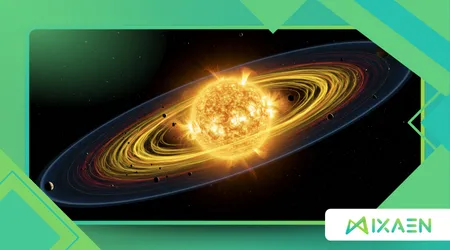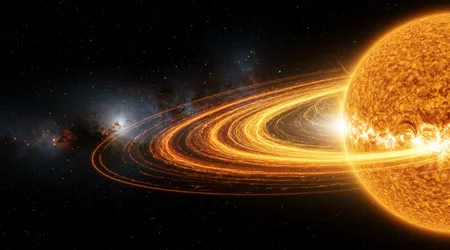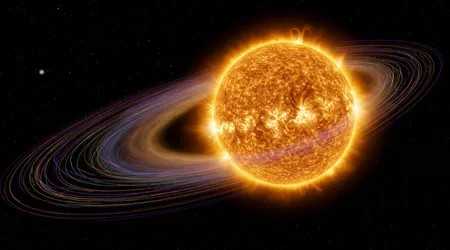How Solar Energy Powers the Heliosphere: Unraveling the Sun’s Cosmic Influence

The Sun, a colossal nuclear furnace, powers the heliosphere by unleashing a relentless stream of charged particles known as the solar wind.
Anúncios
This dynamic flow shapes a vast magnetic bubble that envelops our Solar System, shielding planets from galactic cosmic rays. But how does this stellar engine drive such a cosmic phenomenon?
Let’s dive into the intricate dance of solar energy, magnetic fields, and plasma that defines the heliosphere’s existence in 2025, drawing from cutting-edge research and real-time observations to illuminate this celestial marvel.
The heliosphere is not just a scientific curiosity it’s our Solar System’s protective cocoon. Understanding how the Sun’s energy shapes it offers insights into space weather, planetary habitability, and even the potential for interstellar exploration.
As we approach the solar maximum of Cycle 25, expected in mid-2025, the Sun’s activity is intensifying, making this topic more relevant than ever.
This article explores the mechanisms behind this cosmic shield, blending recent discoveries with practical examples to spark curiosity. Why does the heliosphere matter to us on Earth? Let’s find out.
The Solar Wind: The Engine That Powers the Heliosphere
At the heart of the heliosphere lies the solar wind, a torrent of charged particles mostly protons and electrons ejected from the Sun’s corona.
This plasma stream, traveling at speeds up to 750 km/s, powers the heliosphere by inflating a magnetic bubble that extends far beyond Pluto.
The solar wind’s energy originates from the Sun’s fusion processes, converting hydrogen into helium and releasing immense radiation.
Recent data from NASA’s Solar Dynamics Observatory shows the solar wind’s variability during Solar Cycle 25, with speeds fluctuating between 400–800 km/s.
++ What Causes the Sun’s Differential Rotation? Unraveling the Star’s Dynamic Spin
These variations directly influence the heliosphere’s size and shape. During solar maximum, increased activity strengthens the solar wind, expanding the heliosphere’s boundaries.
Conversely, during solar minimum, the bubble contracts, exposing planets to more cosmic radiation.
Imagine a sailboat pushed by a gusty breeze this is how the solar wind drives the heliosphere, constantly reshaping its structure.
The wind’s interaction with interstellar medium creates a dynamic boundary, a testament to the Sun’s far-reaching influence. Understanding this process helps predict space weather impacts on Earth’s technology.

Magnetic Fields: The Invisible Framework
The Sun’s magnetic field, generated by its internal dynamo, is the invisible scaffold that powers the heliosphere.
This field, rooted in the tachocline, extends into space via the solar wind, creating the interplanetary magnetic field (IMF). The IMF shapes the heliosphere into a tailed, bubble-like structure, as observed by NASA’s Voyager missions.
In 2018, Voyager 2 crossed the heliopause at 119 AU, confirming the magnetic field’s alignment with interstellar fields.
This discovery, complemented by the Interstellar Boundary Explorer (IBEX), revealed a “four-leaf clover” heliotail, showcasing the magnetic field’s role in structuring the heliosphere.
Stronger magnetic activity during solar maximum enhances this framework, fortifying the heliosphere’s shield.
Also read: The Sun as a Laboratory for Studying Plasma Physic
Picture a spider’s web, with magnetic lines guiding the solar wind’s flow. This intricate network not only powers the heliosphere but also deflects harmful cosmic rays, protecting Earth’s atmosphere.
Such dynamics underscore the Sun’s role in maintaining planetary habitability.
The magnetic field’s complexity also drives phenomena like coronal mass ejections (CMEs), which can temporarily reshape the heliosphere.
These events, more frequent in 2025’s solar maximum, inject bursts of plasma that ripple through the magnetic structure, impacting space weather and satellite operations.
Coronal Mass Ejections: Bursts That Shape the Bubble
Coronal mass ejections (CMEs) are explosive bursts of solar plasma and magnetic fields that dramatically influence how the Sun powers the heliosphere.
These events, often tied to solar flares, release billions of tons of material at speeds up to 3,000 km/s. In May 2025, an X2.7 flare triggered radio blackouts, highlighting CMEs’ real-world impacts.
CMEs compress the heliosphere’s boundaries, creating shock waves that accelerate particles into solar energetic particle (SEP) events.
These high-energy particles can penetrate Earth’s magnetosphere, posing risks to astronauts and electronics. The heliosphere’s ability to absorb these shocks demonstrates its resilience as a cosmic shield.
Think of CMEs as sudden gusts in a storm, temporarily distorting the heliosphere’s shape. Their frequency, peaking during solar maximum, underscores the Sun’s dynamic influence.
Read more: The Sun’s Role in Triggering Earth’s Geomagnetic Storms
Monitoring CMEs is crucial for protecting Earth’s technological infrastructure, from power grids to GPS systems.
In 2025, NASA’s IMAP mission, set to launch in February, will provide real-time data on CME interactions with the heliosphere.
This mission aims to map the heliopause, offering new insights into how these explosive events shape our cosmic environment. Such advancements will enhance space weather forecasting.
The Heliosphere’s Boundaries: Where Solar Energy Meets the Cosmos
The heliosphere’s outer edges marked by the termination shock, heliosheath, and heliopause are where solar energy confronts the interstellar medium.
Here, the solar wind slows dramatically, forming the termination shock, then compresses in the heliosheath before yielding to interstellar plasma at the heliopause.
This boundary, roughly 120 AU from the Sun, is where the Sun’s influence wanes.
Voyager 1 and 2 data show the heliopause as a dynamic frontier, fluctuating with solar activity. During solar maximum, increased solar wind pressure pushes the heliopause outward, expanding the region the Sun powers the heliosphere.
IBEX’s 2008 discovery of the “IBEX ribbon” revealed unexpected energetic neutral atom (ENA) patterns, suggesting a complex interplay at this boundary.
Envision a river meeting the sea, where solar wind currents mix with interstellar flows. This interaction shapes the heliosphere’s size and protective capacity.
Understanding these boundaries aids in predicting cosmic ray influx, critical for future lunar and Martian missions.
The heliosphere’s boundaries also influence exoplanet habitability. Planets without strong magnetic fields, like Mars, rely on heliospheric shielding.
NASA’s 2025 research, including IMAP, will deepen our understanding of these cosmic frontiers, informing interstellar exploration strategies.
Solar Cycle 25: A Real-Time Perspective
As we navigate Solar Cycle 25’s peak in 2025, the Sun’s heightened activity amplifies its role in how it powers the heliosphere.
Sunspot numbers, tracked by NOAA, are projected to peak at 115–130, driving stronger solar winds and more frequent CMEs. This intensifies the heliosphere’s expansion, as noted in recent Met Office forecasts.
Increased solar activity enhances the heliosphere’s shielding against galactic cosmic rays, reducing their impact on Earth.
However, it also heightens space weather risks, as seen in recent auroral displays and radio disruptions. Real-time monitoring by NASA’s Solar Dynamics Observatory provides critical data for understanding these effects.
Consider a lighthouse pulsing brighter during a storm this is the Sun during solar maximum, strengthening the heliosphere’s reach.
This dynamic phase offers a unique opportunity to study the Sun’s influence. Ongoing missions like Solar Orbiter will provide detailed insights into these processes.
The table below summarizes key heliospheric features influenced by Solar Cycle 25:
| Feature | Description | Solar Cycle 25 Impact |
|---|---|---|
| Solar Wind Speed | 400–800 km/s, varies with activity | Increases during maximum, expanding heliosphere |
| Heliopause Distance | ~120 AU, fluctuates with solar wind pressure | Pushes outward, enhancing cosmic ray shielding |
| CME Frequency | Bursts of plasma, up to 3,000 km/s | Peaks, causing space weather disruptions |
| Magnetic Field Strength | Shapes heliosphere’s structure | Strengthens, reinforcing heliospheric bubble |
Practical Implications: Why the Heliosphere Matters
The heliosphere’s role extends beyond cosmic curiosity it directly impacts life on Earth. By shielding us from galactic cosmic rays, it protects DNA from radiation damage, crucial for biological systems.
In 2025, NASA’s research highlights how this shield influences satellite longevity and astronaut safety during lunar missions.
Space weather, driven by the Sun’s activity, can disrupt power grids, as seen in the 1989 Quebec blackout.
Understanding how the Sun powers the heliosphere helps forecast these events, safeguarding technology. For example, airlines reroute polar flights during strong CMEs to avoid radiation exposure.
The heliosphere also informs our search for habitable exoplanets. Planets lacking magnetic fields depend on their star’s astrosphere for protection.
Insights from Solar Cycle 25 data will guide future missions, like those planned for Mars, ensuring safer exploration.
Moreover, the heliosphere’s dynamics inspire renewable energy innovation. Solar wind studies parallel advancements in solar panel efficiency, as seen in recent floating solar projects with a global potential of 4,000 GW.
This synergy highlights the Sun’s dual role in cosmic and terrestrial energy systems.
Engaging the Future: What’s Next for Heliospheric Research?

As we stand at the cusp of new discoveries, the question looms: how will our understanding of the heliosphere shape humanity’s cosmic journey?
The IMAP mission, launching in 2025, promises to map the heliosphere’s boundaries with unprecedented detail, revealing how solar energy powers the heliosphere. This will enhance space weather predictions, critical for deep-space missions.
Emerging machine learning models, like those developed at Utah State University, are revolutionizing solar flare and CME forecasting.
These tools analyze vast datasets from spacecraft like Solar Orbiter, offering real-time insights into heliospheric dynamics. Such advancements will bolster our preparedness for solar storms.
The heliosphere also serves as an analogy for resilience a protective bubble adapting to cosmic forces, much like humanity adapts to challenges.
As solar activity peaks, researchers are poised to unlock new secrets, paving the way for interstellar exploration. The Sun’s influence, vast and dynamic, continues to captivate and inspire.
Conclusion: The Sun’s Cosmic Legacy
The Sun’s energy, through solar wind, magnetic fields, and CMEs, powers the heliosphere, crafting a protective shield that defines our place in the cosmos.
As Solar Cycle 25 unfolds, real-time data from missions like IMAP and Solar Orbiter deepen our understanding, bridging science and practical applications.
From safeguarding Earth’s technology to informing exoplanet research, the heliosphere’s significance is profound.
By unraveling how solar energy shapes this vast bubble, we not only protect our world but also fuel our ambition to explore beyond.
The Sun’s cosmic legacy, vibrant in 2025, invites us to look upward and dream bigger.
Frequently Asked Questions
What is the heliosphere, and why is it important?
The heliosphere is a magnetic bubble created by the Sun’s solar wind, shielding planets from cosmic radiation. It’s vital for protecting Earth’s atmosphere and technology.
How does solar energy influence the heliosphere’s size?
Solar energy, via solar wind and CMEs, expands the heliosphere during solar maximum, pushing its boundaries outward, as observed by Voyager and IBEX missions.
Can the heliosphere affect Earth’s technology?
Yes, heliospheric dynamics, driven by CMEs, can cause space weather events, disrupting satellites, power grids, and communications, as seen in recent 2025 solar flares.
What role does Solar Cycle 25 play in heliospheric research?
Solar Cycle 25’s peak in 2025 increases solar activity, enhancing heliospheric shielding and providing data for missions like IMAP to study its boundaries.
How does the heliosphere relate to exoplanet habitability?
The heliosphere’s shielding against cosmic rays informs how stellar astrospheres protect exoplanets, guiding the search for habitable worlds beyond our Solar System.
